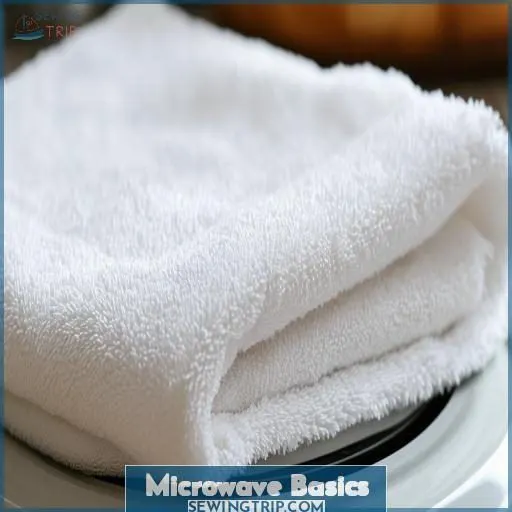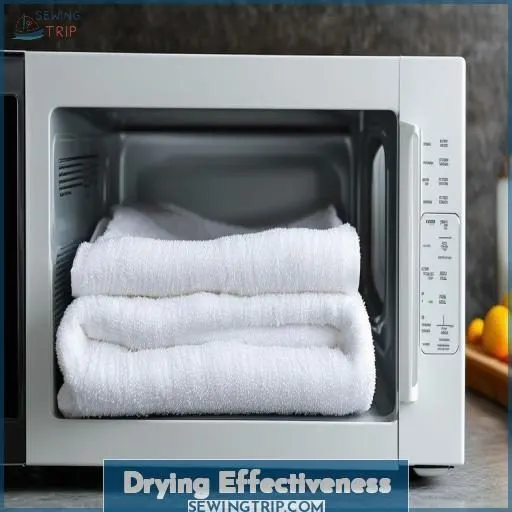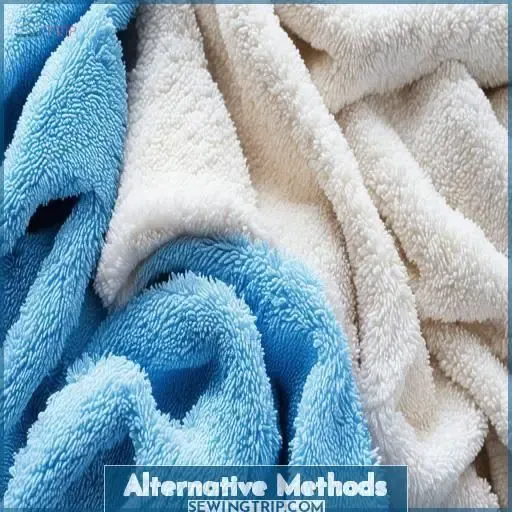This site is supported by our readers. We may earn a commission, at no cost to you, if you purchase through links.

Microwaves generate concentrated heat that can easily lead to fires, clothing damage like fading or shrinkage, and potentially hazardous static buildup.
Even if you manage to avoid these dangers, the uneven heating makes achieving consistent dryness nearly impossible.
Instead of risking a laundry disaster, you’re far better off exploring safer alternatives that won’t endanger you or your garments.
If you’d like to learn about more effective and secure drying methods, read on.
Table Of Contents
Key Takeaways
- Drying clothes in the microwave is a recipe for disaster – it’s like playing a high-stakes game of "Will it Burn?" Ain’t nobody got time for that!
- Sure, microwaves zap moisture out of food, but they’ll also zap the life out of your clothes. Faded colors, shrunken fits, and static galore – it’s a laundry apocalypse waiting to happen.
- Even if you somehow manage to avoid starting a raging inferno, you’ll still end up with an inconsistent, half-baked drying job. It’s like trying to bake a soufflé in a hurricane – not going to happen!
- Do yourself a favor and stick to tried-and-true drying methods. Air drying, portable dryers, or even hitting up the old laundromat are way safer bets than nuking your clothes into oblivion.
Can You Dry Clothes in the Microwave Towel?
No, you can’t dry clothes in a microwave towel. It poses significant fire risks and can damage both the clothes and the microwave itself.
Microwave Basics
To understand the concept of drying clothes in a microwave, begin with the basics. A microwave uses electromagnetic waves to generate heat. Microwave power varies, typically ranging from 600 to 1200 watts. This affects how quickly your items heat. Microwaves have different heating settings, designed for various foods, but not clothing. The door latch guarantees the microwave operates only when securely closed. Timer settings control the duration, essential for ensuring safety.
Safety precautions include making sure to use microwave-safe containers, and never leaving it unattended while in use. Microwaves aren’t designed for fabrics, and misuse can lead to hazards. Understanding these basic features and functions is important for avoiding risks when considering unconventional uses.
Fabric Compatibility
When drying clothes in a microwave, fabric compatibility is paramount. Grasping how natural fibers, synthetic fibers, and blended fabrics respond to microwave heat guarantees safety and avoids damage.
Natural Fibers
When considering drying clothes in a microwave, natural fibers like cotton, linen, and wool need special attention. These fibers are known for their moisture absorption and biodegradability, but they may wrinkle and lose colorfastness under intense heat. Additionally, these materials might become damaged, risking fire hazards and compromising the integrity of both the clothing and the microwave.
Synthetic Fibers
Drying synthetic fibers in a microwave can lead to several issues. Expect static electricity buildup, which can damage electronics. Fiber degradation may occur, reducing fabric strength. Color fading is another concern, altering the garment’s appearance. Finally, shape distortion and shrinkage can ruin the fit, making microwave drying an unsuitable method for synthetics.
Blended Fabrics
Blended fabrics combine fibers for enhanced qualities like fabric composition, heat tolerance, and moisture absorption (Source). However, microwaving them can lead to uneven drying and potential damage. Drying efficiency varies with blending techniques, so they mightn’t handle the heat well. Always check care labels to avoid fire hazards or ruining your clothes .
Safety Concerns
Drying clothes in a microwave towel can pose significant fire hazards, risk damaging your garments, and compromise your microwave’s integrity. Always prioritize safety to avoid accidents and consider alternative drying methods to prevent any mishaps.
Fire Hazards
Using a microwave to dry clothes presents significant fire hazards. Microwave energy interacts unevenly with fabrics, leading to potential hotspots, especially in thick materials. Without proper ventilation, heat can’t escape, increasing fire risk. Always adhere to safety precautions, monitoring closely to prevent overheating and potential ignition (Source).
Clothing Damage
Microwaving clothes can cause fading, shrinkage, and wrinkles, compromising your fabric’s quality. Brightly colored garments may experience color bleeding, leading to ruined batches of laundry. Additionally, static buildup is a common issue, making clothes cling together. These risks make microwaving an unreliable method for drying clothing safely, potentially causing more harm than benefit.
Microwave Integrity
When drying clothes in a microwave, consider microwave integrity to prevent damage and hazards.
- Microwave Emissions: Clothes can absorb microwave radiation, potentially causing overheating.
- Radiation Absorption: Certain fabrics can trap heat unevenly, risking fire.
- Door Seal Integrity: A damaged seal may leak radiation.
- Power Fluctuations: Overloading can strain the microwave’s components, leading to failures.
Drying Effectiveness
Drying clothes in the microwave isn’t highly effective due to inconsistent moisture levels and uneven drying. The drying time can vary considerably, leading to potential fabric damage.
Moisture Levels
To guarantee effective drying, account for the moisture absorption, evaporation rates, and humidity levels. The material thickness and fabric weight markedly impact the drying process as well. Observing these factors promotes even and efficient drying.
| Moisture Levels | Factors | Impact |
|---|---|---|
| High | Dense fabric weight | Slow evaporation rates |
| Moderate | Medium fabric thickness | Balanced drying |
| Low | Light material | Fast moisture removal |
Drying Time
Drying efficiency in a microwave is suboptimal, leading to uneven drying and potential fabric degradation. You’ll face:
- Longer drying times
- Hot, dry spots amidst damp areas
- Wear and tear on delicate fabrics
- Fire hazards if overdried
Exercise caution when microwaving clothes, as drying duration often exceeds expectations. Consider safer alternatives for efficient, uniform drying.
Even Drying
Speaking of drying time, even drying is essential. Microwaves don’t distribute heat evenly, causing some areas to dry faster than others.
| Dry | Damp | Soggy |
|---|---|---|
| Fibers Weak | Mildew Risk | Mold Hazard |
| Heat Damage | Odor Issues | Fabric Breakdown |
| Quality Loss | Rewetting Needed | Complete Redry |
Heating distribution and material density impact drying uniformity, often leaving frustrating wet patches.
Alternative Methods
While the risks associated with drying clothes in a microwave make it an inadvisable option, you can explore safer alternatives like air drying your garments or investing in a portable dryer for small loads. If neither of those suit your needs, consider utilizing laundromat services for a more convenient and effective drying solution.
Air Drying
While air drying may seem like a convenient alternative, it has its drawbacks:
- Lengthy drying times, especially in humid conditions
- Risk of mildew or musty odors if not dried thoroughly
- Potential for wrinkles or stiff fabric textures
However, air drying is eco-friendly, cost-effective, and gentle on fabrics when done properly. Consider these tips for desirable results:
- Use drying racks or clotheslines in well-ventilated areas
- Rotate and flip garments periodically for even drying
- Avoid direct sunlight to prevent fading or damage
Portable Dryers
If you’re often on the go, a portable dryer might be your best bet. These compact, energy-efficient units are easy to use and travel-friendly, making them ideal for small spaces or taking along on trips.
| Feature | Benefit |
|---|---|
| Compact Size | Space-saving convenience |
| Efficient Design | Energy savings |
| Portability | Travel-ready drying |
| User-Friendly | Simple operation |
While not as powerful as full-size dryers, portable models offer a convenient drying solution.
Laundromat Services
Another convenient option is using a laundromat or coin laundry service. While it requires leaving your home, you can:
- Utilize large, industrial-sized machines for bulky loads
- Guarantee proper machine maintenance for effective drying
- Access detergent and fabric softener options suitable for different fabrics
At a laundromat, you can efficiently dry clothes without compromising safety or fabric quality.
Frequently Asked Questions (FAQs)
How do microwaves affect fabric fibers?
Microwaves disrupt hydrogen bonds, causing fabric fibers to lose moisture rapidly. This extreme drying can damage delicate fabrics, leading to shrinkage or discoloration. It’s best to air-dry or use a conventional dryer for clothing.
What are the fire risks involved?
Microwaving clothes is incredibly risky – the high heat can easily ignite fabrics, causing devastating fires. It’s never worth the danger. Air drying or using proper drying equipment is essential for safety.
How long does it take to dry?
While microwaving may seem quick, it’ll scorch your clothes. Drying garments properly takes 30-60 minutes in a vented dryer – be patient for best results. Microwaves work by vibrating water molecules, which can damage fabrics. Play it safe and stick to conventional drying methods.
Can you dry delicate fabrics this way?
No, microwaving delicate fabrics is ill-advised. The intense heat and moisture can cause irreversible damage or shrinkage. Stick to gentle machine or air drying for your delicates.
Are there any energy-saving benefits?
Like a rain shower after a drought, using a microwave to dry clothes may quench your thirst for efficiency, but the energy savings are mere droplets. Conventional drying methods remain the wisest path for your utility bills.
Conclusion
Ye olden days of drying clothes with a microwave towel are long gone. The risks far outweigh any perceived convenience. Instead, embrace safe and reliable methods like air drying or investing in a portable dryer. Your clothes (and safety) will thank you for avoiding this laundry mishap. Make the sensible choice – keep microwaves for food, not fabrics.











